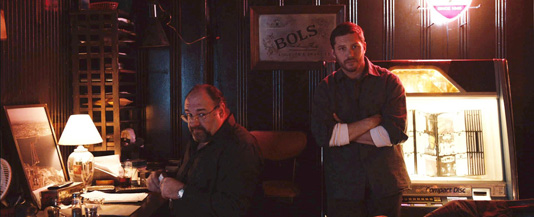Movie Review: The Drop
By Matthew Huntley
September 22, 2014
BoxOfficeProphets.com

Bob tells us in the opening prologue of The Drop that the bar he tends, along with several others in the area, serves as a drop, or temporary holding place, for all the “dirty” money controlled by the ruling criminal elite. We never learn where this money comes from or how it’s made, which is fine, because the only thing we need to know is it’s dirty and belongs to some very dangerous people. And if you mess with the money, you invariably mess with the people.
Fortunately, The Drop is neither about the money nor the criminals to whom it belongs. I write “fortunately” because it seems like we’ve seen that crime movie before, in some shape or form. Instead, The Drop is about the people one or two levels down - the middlemen, if you will - who simply make sure the drop happens without interference and who are smart enough not to ask questions. They do this, we assume, because they feel they have no other choice. It’s not like they can just leave. After all, this is their neighborhood and it’s where they call home.
The underlying theme of film is that things aren’t always what they seem, which, in a way, describes the film itself. At first, we assume The Drop will play out like any standard crime drama, and our assumptions are somewhat correct when we meet the reigning crime bosses: bearded, leather-jacket-wearing Chechens of few words. Their sole purpose, it seems, is to either torture people or ask about their money. Beyond that, they’re hardly developed.
It’s when the film focuses on Bob (Tom Hardy), Nadia (Noomi Rapace) and Marv (James Gandolfini) that it gains traction and a sense of uniqueness. When the Chechens moved into the neighborhood, they deposed Marv as the big cheese, making him and his bar, aptly named Cousin Marv’s, their bitch. This is something Marv never fully swallowed and he tells Bob, who happens to be his real cousin, “When I walked into a place, people sat up straight, they noticed. I was respected. I was feared.” He and Bob used to be “tough guys,” as they’re called, but not anymore. Now they answer to somebody instead of the other way around. And when Cousin Marv’s is held up by a couple of low-level robbers, it’s automatically on Bob and Marv to retrieve the stolen drop money.
But the plot gets more complex. One night after closing up shop, Bob walks down the street and hears a puppy crying. A black pit-bull, beaten and scarred, has been tossed into a garbage can outside the house of Nadia, who’s so cautious and fearful she immediately asks Bob for his driver’s license, snaps a picture, and sends it to her friends. Just in case.
After Bob decides to adopt the puppy and name him Rocco, he and Nadia strike up an uncommon friendship, perhaps even a slight romance. As pleasant as this seems, we know there are a few things these two aren’t revealing about themselves, not least how Nadia got those scars on her neck. Things get even more complicated when a good-for-nothing thug named Eric Deeds (Matthias Schoenaerts) comes around claiming to be the dog’s owner and starts making threats unless Bob pays him off.
Meanwhile, Detective Torres (John Ortiz) keeps pressing Bob and the bar’s patrons for answers related to the burglary. Torres isn’t stupid and knows Cousin Marv’s plays a role in the city’s illegalities, but Bob remains guarded and enigmatic, telling the detective, “That’s just this neighborhood.”
How all of these characters intertwine and the fates they meet, I leave you to discover, but the film proves quite effective as it digs into the current and past lives of its people. Director Michaël R. Roskam’s approach to Dennis Lehane’s screenplay, based on his short story, “Animal Rescue,” is slow and simmering at first, but once all the threads come together and the story reaches its boiling point, we come to admire Roskam’s patience and restraint. We’re able to see how the characters, and the actors who play them, have multiple layers, which shakes up an otherwise familiar premise. We walk away from “The Drop” thinking we’ve gained a different perspective on the world of organized crime, which makes it refreshing.
One other thing worth mentioning is the film’s atmosphere. Though it appears relatively indistinct, the production design, art decoration and set decoration fuse to create a cold and drafty environment. It’s fairly obvious these elements are meant to serve as extensions of the characters and their chosen lifestyles, but nevertheless, they put us in the middle of their world. Small details like dilapidated porches, broken tchotchkes, and old, dusty rugs in the basements say a lot about who these people are. We don’t envy them, but we gain a sense of what it’s like to be them, which is a sign of the film’s efficacy.